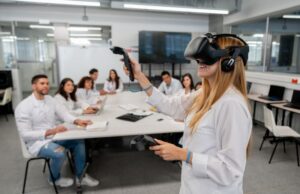Technology is transforming the way schools function. As the world becomes increasingly digital, the way children learn, communicate, and access information is also changing. Educational technology (EdTech) has become a key factor in transforming classrooms, the way teachers teach, and student engagement. These changes aren’t fleeting; they’re shaping the future of learning. From artificial intelligence platforms to immersive virtual reality experiences, EdTech trends are changing the way people learn and teach worldwide.
The Application of AI in Personalized Learning
The rise of artificial intelligence (AI) in education is one of the most important EdTech trends. AI enables each student to have a unique learning experience, tailored to their skills, weaknesses, learning speed, and interests. Students can use AI tools to receive rapid feedback, customized courses, and personalized support based on their performance. AI can also analyze data to help teachers identify gaps in student learning and adjust their teaching methods. This approach makes education more student-centered and helps every student reach their full potential, something traditional, one-size-fits-all approaches can’t.
Virtual Reality and Augmented Reality Experiences
Virtual reality (VR) and augmented reality (AR) create learning environments that were once inaccessible. Today, students can visit ancient cities, experience the human circulatory system, or visit science labs, all from the classroom or at home. These tools make learning more engaging and interactive because students can experience things themselves instead of just reading about them. 3D graphics and interactive interfaces can help students understand complex scientific concepts, historical events, and engineering models. This trend is particularly effective in stimulating student interest and making it easier to grasp difficult concepts.
Using Gamification to Motivate
Gamification, which applies game-like elements to non-game environments, is becoming a popular trend in schools. Earning points, badges, and awards increases student engagement. Gamified learning platforms transform learning into a series of challenges, sparking interest and motivation, making learning fun. This approach is effective not only for younger students accustomed to video games but also for older students, as it can make boring or difficult assignments more engaging. Gamification changes students’ perceptions of school, making learning a more engaging and meaningful experience.
Distance and Hybrid Learning Models
The COVID-19 pandemic has expedited the adoption of distance and hybrid learning models, and we anticipate this trend to persist. While traditional schools have resumed, many still offer flexible online and blended learning options. Using distance learning systems, students can access courses, submit assignments, and interact with other students and teachers anytime, anywhere. Blended learning approaches combine in-person and online instruction to create a more flexible and welcoming learning environment. This flexibility is especially beneficial for students with varying needs, schedules, or locations. This also means that learning structures will change from now on.
Cloud Storage and Collaboration
Cloud technology is crucial for modern education because it offers storage, access, and collaboration capabilities. Students and teachers can now work on the same exam, access course materials, and securely store data from any internet-connected device. This convenient access allows people to continue learning and collaborate seamlessly on projects and group assignments. Google Workspace for Education and Microsoft Teams are essential tools in this trend. They create a digital platform for learning anytime, anywhere. Cloud technology has effectively dismantled the traditional boundaries of the classroom.
Data-Based Learning Analytics and Insights
Learning analytics is a new trend in education that uses data to help students improve. Data is becoming increasingly important in this field. By monitoring student performance, attendance, engagement, and behavior, teachers can make informed choices to help individual students and the class as a whole. These insights can help teachers identify students who need additional support, adjust their teaching methods, and understand the effectiveness of their lessons. AI can even help learning analytics
Learning Analytics and Data-Driven Insights
Data is becoming a valuable asset in the education sector, and learning analytics is an emerging trend that uses data to improve student outcomes. By tracking performance, attendance, engagement, and behavior, educators can make informed decisions that benefit both individual learners and entire classrooms. These insights help in identifying students who need extra support, adjusting teaching methods, and measuring the effectiveness of educational programs. With the help of AI, learning analytics can even predict future performance and suggest interventions before problems arise. This proactive approach is reshaping how progress is measured and supported.
Blockchain Technology for Credentialing
Blockchain technology is revolutionizing the verification of academic qualifications and achievements. While traditional diplomas and certificates are easily lost or falsified, blockchain offers a secure and public way to track educational achievement. Institutions can provide students with secure, immutable digital qualifications, giving them control over their academic records. This technology is particularly useful in higher education and the job market, where demonstrating talent and qualifications is crucial. Blockchain can improve the efficiency of admissions, recruitment, and further education, shortening the entire school-to-work process.
AI Tutors and Chatbots
AI tutors and chatbots are constantly improving. They can now answer students’ questions, provide explanations, and help them understand complex topics. These virtual assistants are always available, so help is always available. For students who are hesitant to ask questions during class or who study outside of regular hours, AI tutors are a valuable resource. These algorithms are constantly learning and improving, making their accuracy and responsiveness increasingly faster over time. This trend is transforming the role of educational support by making it easier to get immediate help and reducing the need for a human to answer every question.
Conclusion
Edtech trends are changing the way we teach, learn, and thrive in school. The tools and technologies we have today make education more flexible, accessible, and practical for everyone. Personalized, AI-powered learning and immersive virtual experiences are two examples. These developments are not passing fads; they are transforming the way we learn in the future. To stay ahead of the curve, teachers, students, and schools must adapt and embrace the changes brought about by new technologies. Edtech is leading the way in smarter, more connected, and more equitable education systems.
FAQs
1. What are the latest trends in edtech?
Edtech trends refer to new technologies and practices that are transforming education, such as artificial intelligence, virtual reality, mobile learning, and gamification.
2. How are these trends improving schools?
These trends make learning more engaging, personalized, adaptable, and accessible for everyone, helping students and teachers achieve better results.
3. Are edtech trends suitable for all ages?
Yes, edtech tools and platforms are accessible to people of all ages, from elementary school students to adults who want to study or work.
4. Is edtech only for online learning?
Edtech has improved online learning and benefited traditional classrooms by providing teachers with digital tools and resources that make learning more fun and engaging.
5. Will these models continue to evolve in the future?
Yes, edtech will likely continue to evolve, become more sophisticated, and expand its use in schools worldwide.




